Eggplant is twice-cooked to melting perfection in this easy, rich Vegetarian Lebanese Eggplant Moussaka with Chickpeas (garbanzo beans).
Gloriously delicious, gloriously simple. Despite its Moussaka name, this Lebanese Eggplant and Chickpea dish (also known as Maghmour) is vegan. Unlike the Greek Moussaka, there is no béchamel sauce and no meat in this easy vegetarian alternative.
I love that the eggplants (aubergines) are cooked twice, firstly fried and then baked. I find that this two-step cooking process deliciously intensifies the smoky flavours and melting silken texture of the eggplant.
Great hot or cold. I like to have this Lebanese Moussaka with Chickpeas on stand-by in the fridge. I then have a no-fuss ready-made light lunch or supper, perfect with just some pitta bread or a hunk of crusty bread to mop up the gloriously rich tomato sauce. For a more substantial meal, you can serve this chickpea dish with couscous, rice or pasta.
For a true Lebanese feast, enjoy this Eggplant and Chickpea Moussaka as part of a Mezze meal. Lebanese Moussaka is perfect with a refreshing Authentic Lebanese Tabbouleh, with lemon-soaked bulgur, diced tomatoes, fresh mint and parsley.
Jump to:
Ingredients
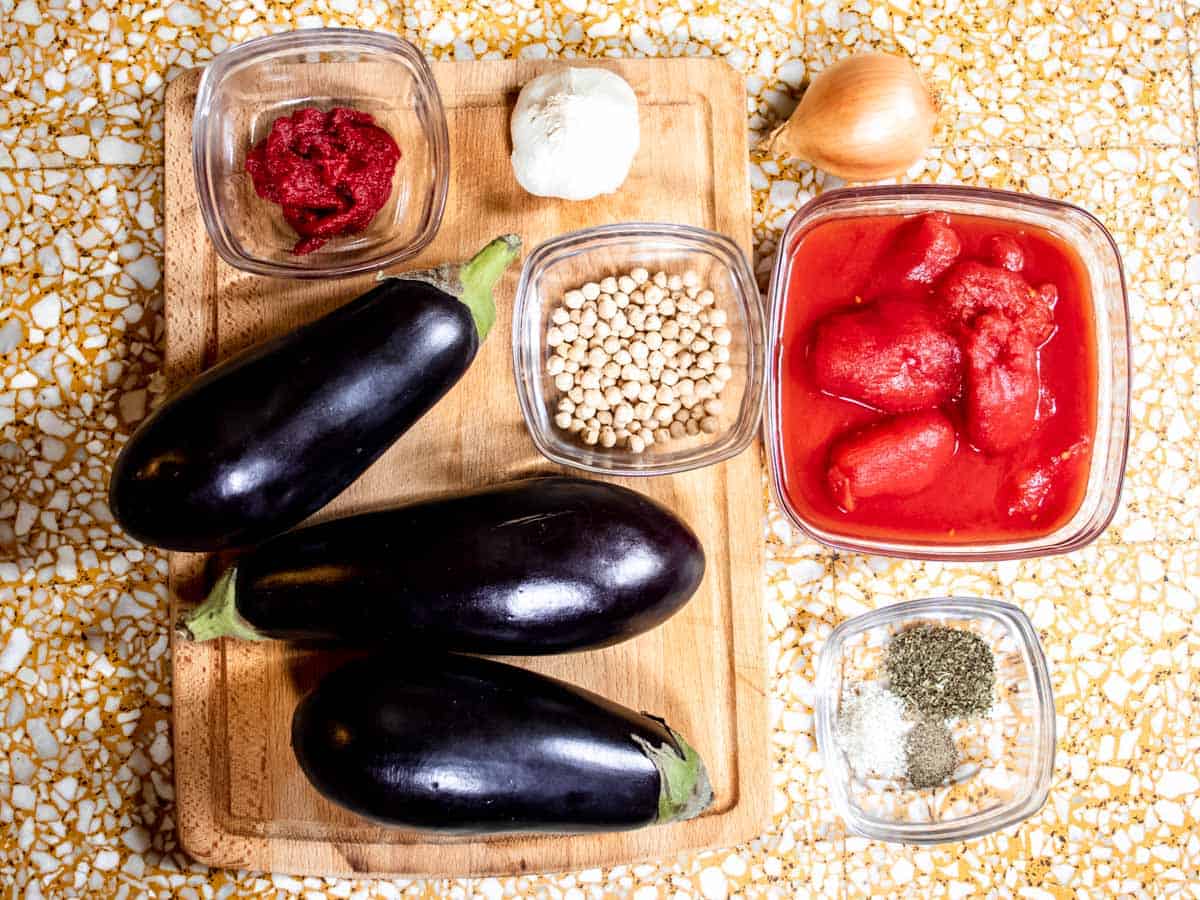
- Chickpeas. Dried or canned chickpeas work well.
- Bicarbonate of soda (not shown in photograph). If you use dried chickpeas, I recommend that you add a little bicarbonate of soda to the water you soak the chickpeas in to help soften them.
- Sunflower oil (or other suitable oil for frying the eggplants)(not shown in photograph)
- Eggplant (aubergine). I used the commonly found globe eggplant.
- Olive oil (not shown in photograph)
- Onion.
- Garlic.
- Tomatoes. You can use fresh ripe tomatoes or canned tomatoes, but tinned tomatoes are best if you are not able to get juicy, sun-ripened fresh tomatoes.
- Tomato paste (puree). An optional ingredient, but I find that adding some tomato paste really intensifies the tomato sauce.
- Mint (optional). Dried mint or fresh mint.
- Salt and Pepper.
See the Recipe Card below for quantities and the full recipe.
Useful Equipment
No special equipment is needed for this Lebanese Moussaka recipe. I have listed the key useful items below.
- chopping knives for preparing the aubergines, onions and garlic
- deep frying pan such as a sauté pan
- strainer
- bowl or other container for straining excess oil into
- large saucepan
- baking dish
How to Make Lebanese Moussaka
Soak & Cook Dried Chickpeas. Ideally start this stage a day ahead. If using canned chickpeas, ignore this step and skip straight across to Moussaka Step 1.
I soak dried chickpeas for at least 12 hours in plenty of water (usually overnight). I also add half a teaspoon of bicarbonate of soda to the water in which the dry chickpeas are soaked. Before cooking the chickpeas I replace the water that the chickpeas have been soaked in with fresh water. I then boil the chickpeas (making sure always covered with water) until cooked. This takes about 1 hour to 1 hour 30 mins.
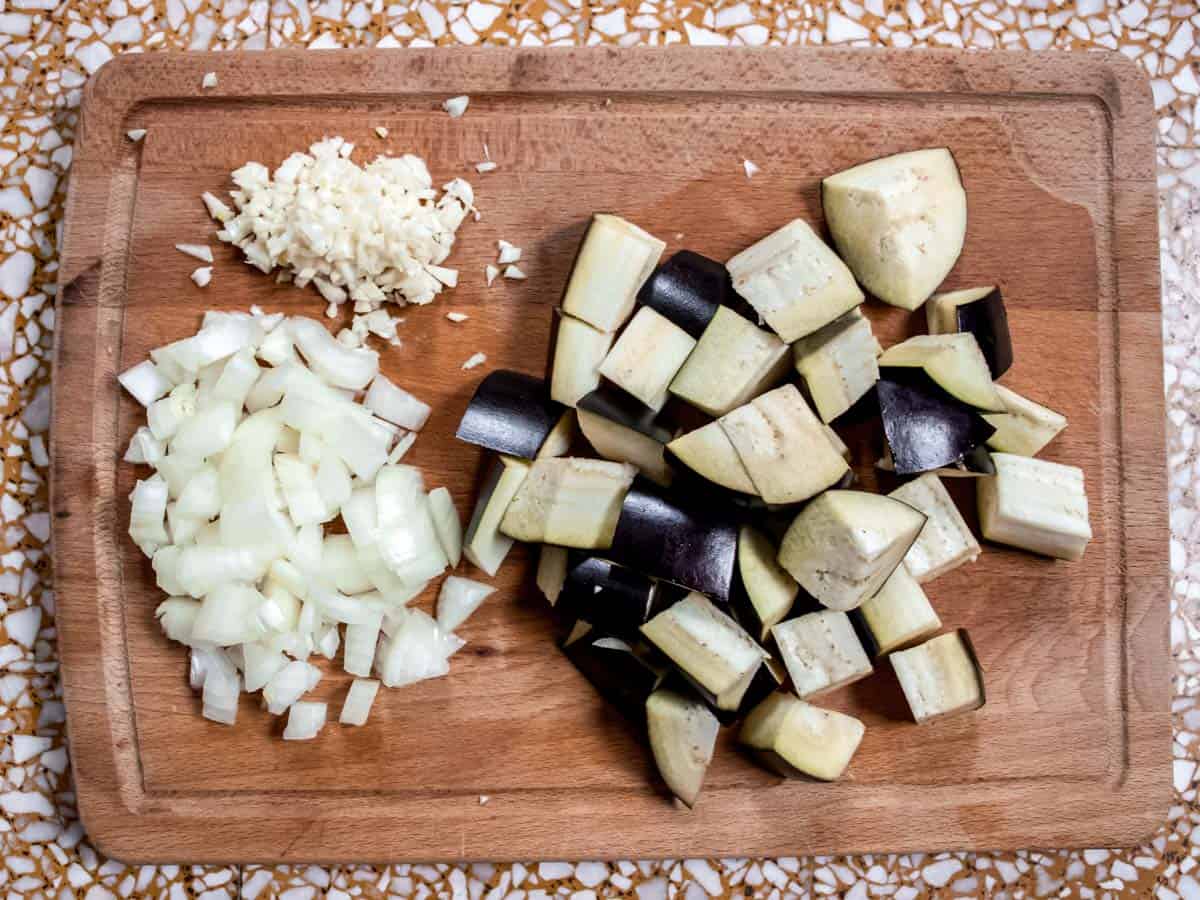
Step 1. I cut the eggplants (aubergines) into roughly 1.5cm (0.5 inches) cubes. Peel and finely chop the onions and garlic cloves.
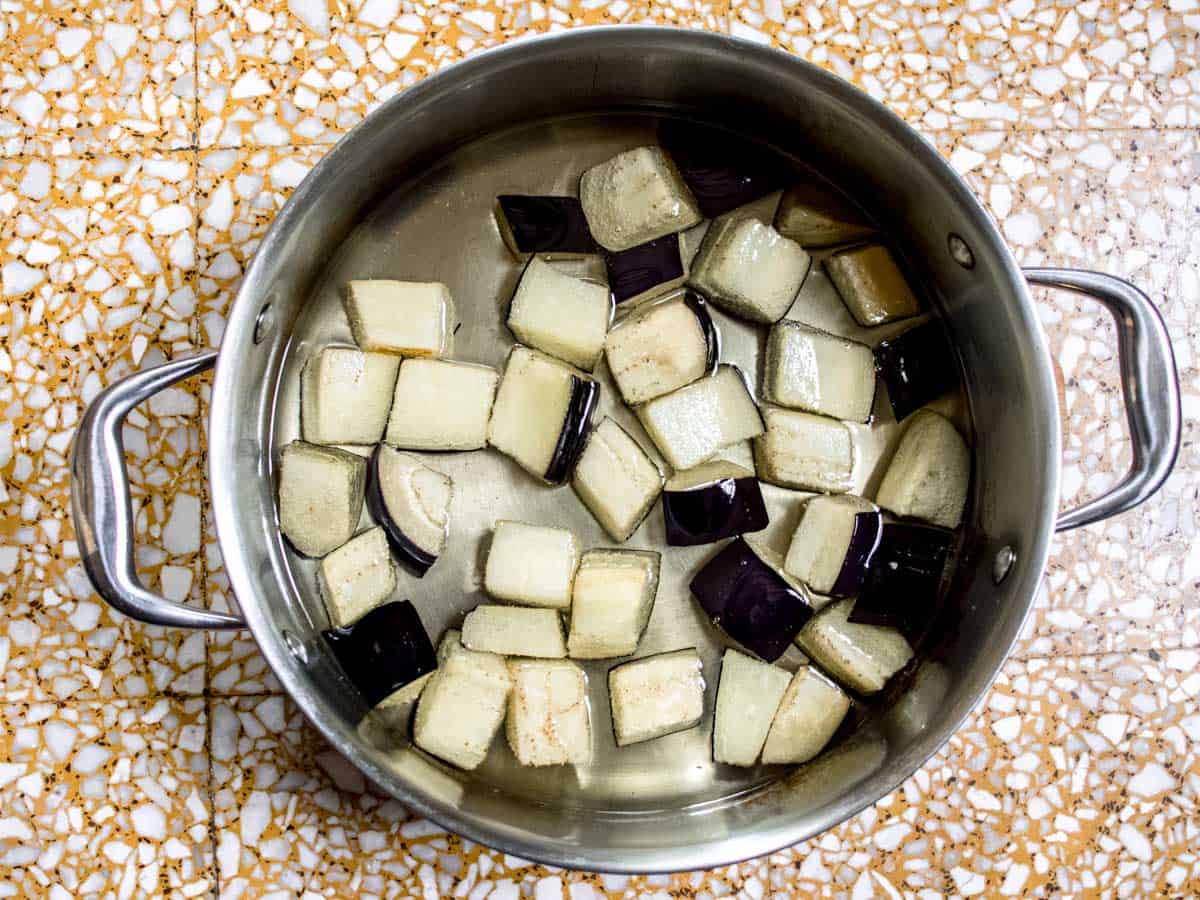
Step 2. Put oil into a frying pan, preferably a sauté pan, so that it is about 1cm in depth. Heat the oil. I heat the oil until I can see it shimmering very slightly on the surface. Frying the eggplant cubes in batches, I make sure that the cubes are not tightly packed and keep to just one layer in the frying pan. I fry the cubes until they start to change colour and go brown on one or two sides.
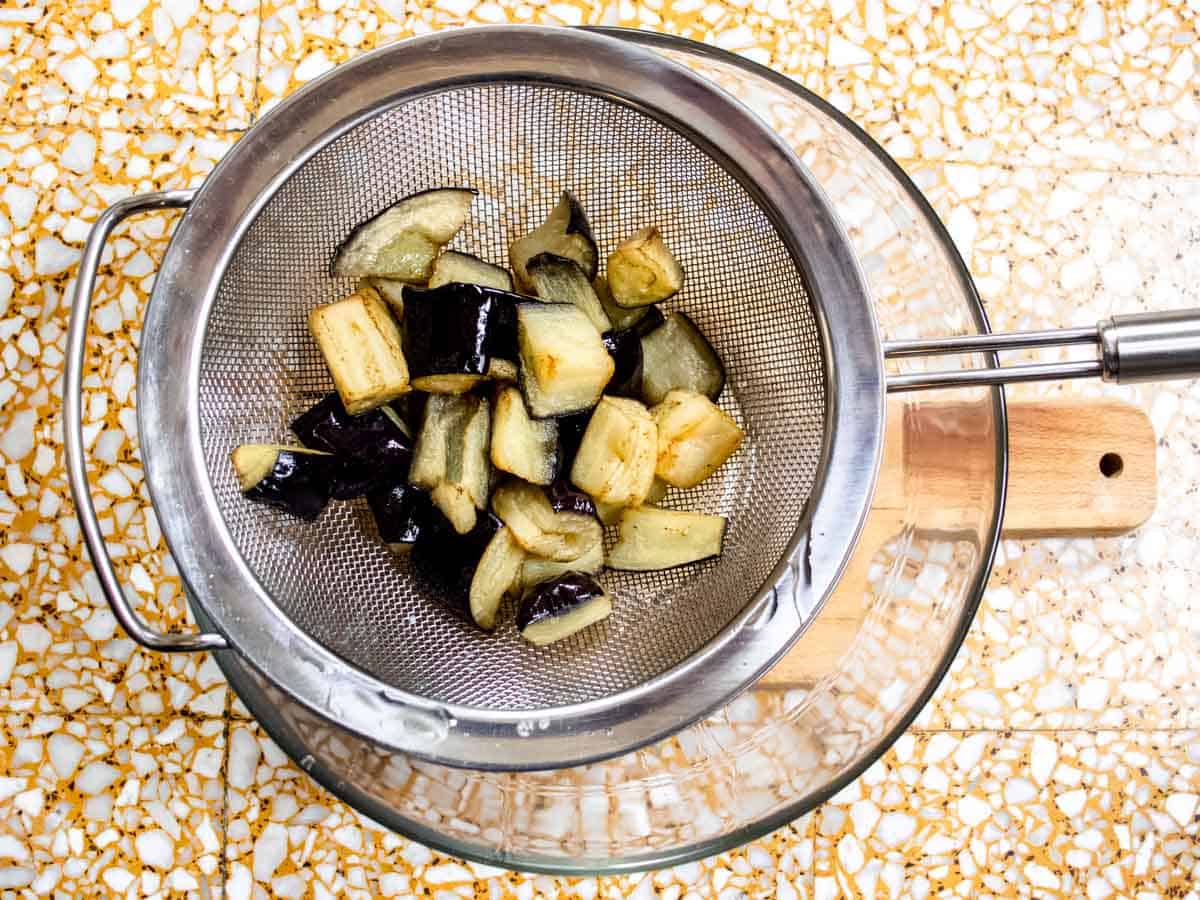
Step 3. Using a slotted spoon, I remove the cooked aubergine (eggplant) from the frying pan and drain each batch of cooked eggplant using a colander or sieve to remove some of the excess oil.
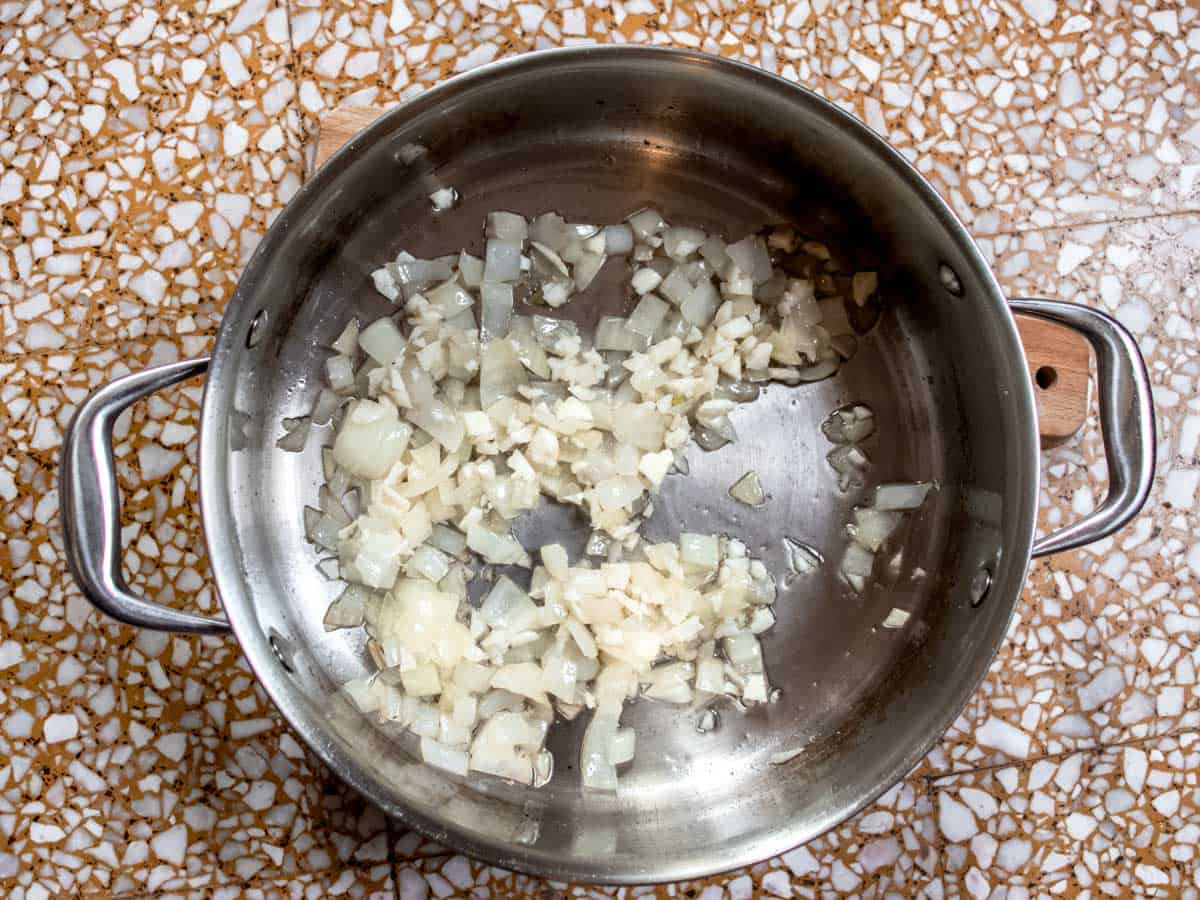
Step 4. Separately, I put olive oil in a frying pan and add the chopped onions, together with a pinch of salt. Cook the onions over a medium heat so that they soften, to the point of starting to “melt” and lose their shape. Add the chopped garlic and continue cooking for a further couple of minutes, stirring to ensure that the all the garlic is gently fried.
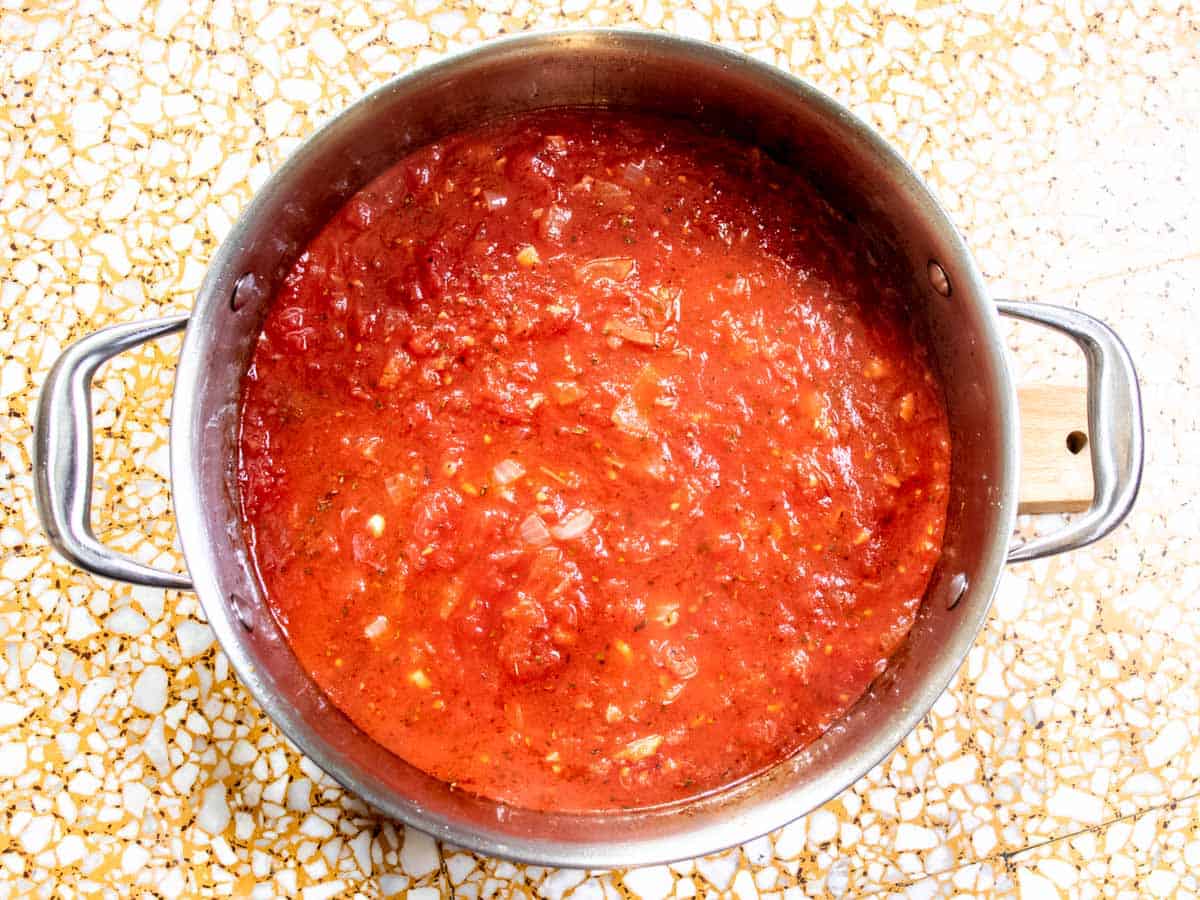
Step 5. Add the tomatoes (if using whole tomatoes chop these first), mint (if using) and tomato paste to the onion mixture. Stir and continue to cook for about 20 minutes or so over a low heat. If the mixture starts to look too dry, add a little water to maintain the rich tomato sauce. Add salt and black pepper to taste.
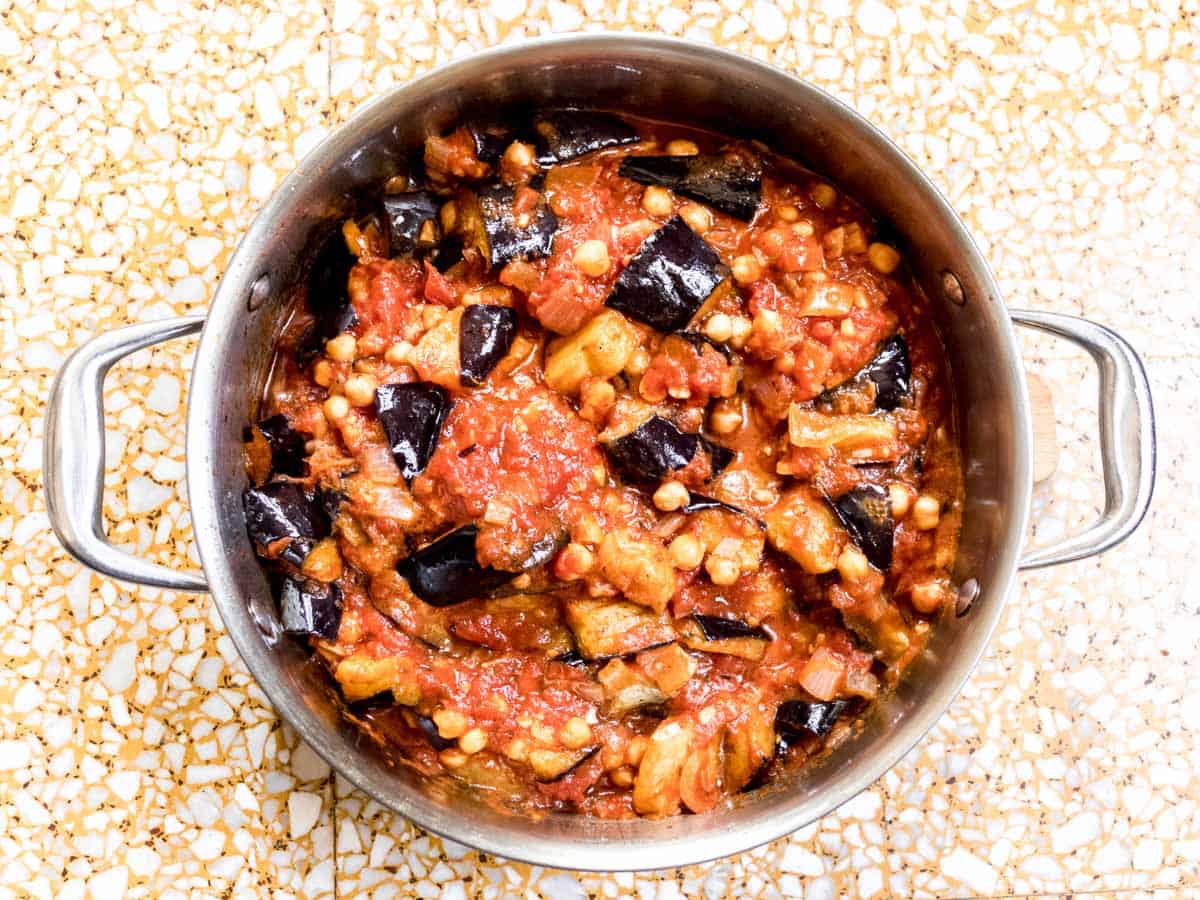
Step 6. Add the chopped eggplants and cooked chickpeas (or canned if using) to the tomato mixture. Stir so that all ingredients are mixed well. Taste and adjust the seasoning as needed.
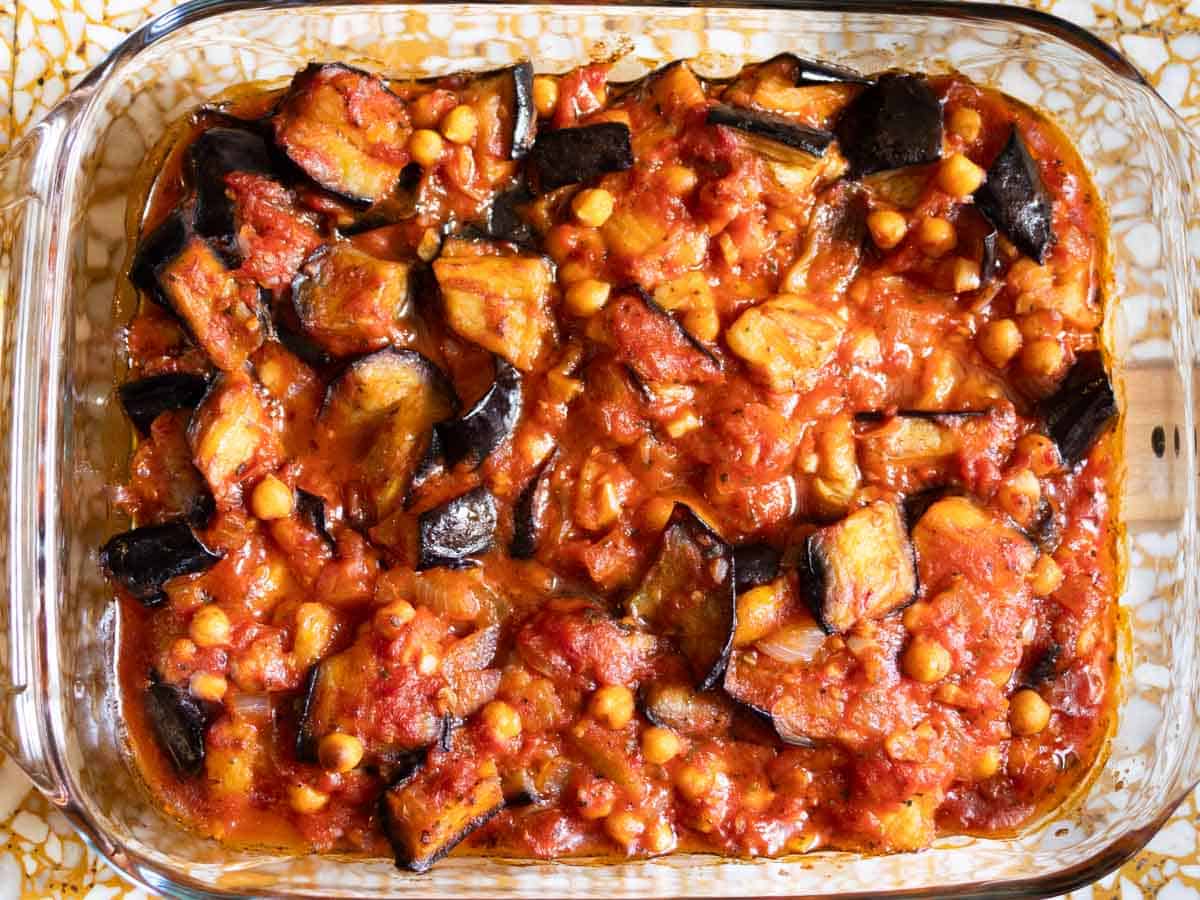
Step 7. Put the mixture into a baking dish. Bake the chickpea and aubergine stew for about 30 minutes.
How to Prepare the Aubergines
Peeling
I’m too lazy to part-peel the aubergines before cooking, as you may find recommended in some recipes for Lebanese Moussaka. By part-peeling, I mean peeling the eggplants lengthwise to leave stripes of peel remaining. The skin does have a more intense smoky taste than the flesh of the eggplant, and it is, of course, tougher. If you want to soften the intensity of the eggplant flavour and texture, part-peeling will help with this.
Fry or Roast?
It’s true that by frying the aubergines in oil, some of that is taken up by the aubergine. For me, this is a bonus. I think it enhances the flavour of the aubergine, and the added oil helps create that richness in the tomato sauce. Draining the fried aubergine after cooking for a few minutes will take away much of the excess oil.
Roasting the eggplants is a great method, however, for minimising the amount of oil used. Roasting can also cut down the time preparing for this dish.
How to Roast the Eggplant Cubes
Set the oven at a high temperature (425F/218C). Put the cubes of eggplants into a large bowl. I add about 4 or 5 tablespoons of oil, and stir the eggplant cubes to coat them evenly with a light film of oil. Put a sheet of parchment (baking) paper onto a baking sheet or roasting dish and spread the oil covered cubes across the baking tray. I try to make sure that the cubes are not crowded. This allows them to get golden brown. Put the aubergine (eggplant) cubes into the hot, preheated over and roast for about 20 to 30 minutes.
Inspiration and Sources
I used Hussien Dekmak's version of Lebanese Moussaka in The Lebanese Cookbook as my starting point, but have strayed from the original recipe a little.
Rather than slicing the eggplants lengthwise as done in The Lebanese Cookbook’s version, I prefer the slightly simpler method of cubing the aubergines and mixing the fried cubes into the chickpea mix. I also like to add mint (not included in the original recipe) to Lebanese Moussaka to give freshness.
Various recipes for Moussaka, with varying names, can in fact be found across many parts of the Middle East, including Egypt, Turkey and Saudi Arabia, as well as parts of Europe (such as Bulgaria and Romania). Often with meat, but there are vegan and vegetarian versions of Moussaka as well, such as this Lebanese Moussaka recipe.
The word "Moussaka" seems to have a number of meanings, including "cold" or "moistened" with the word said to have originated from Arabic. Certainly this Lebanese Moussaka, glistening in oil, can be described as moistened and is perfect served cold. Want to know more? There is a great article by Felicity Cloake in the National Geographic on "Everything you need to know about moussaka".
Storage
I generally store the Lebanese Moussaka in an airtight container in the fridge for no more than 3-4 days. After a few days, I find that the skin of the aubergines can discolour the chickpeas, but this does not seem to affect the flavour.
Can you freeze Lebanese Moussaka?
Yes. I like to freeze Lebanese Eggplant Moussaka after all the ingredients have been mixed together (Step 7 of the Recipe Card). I let the mixture cool and put it in an air-tight container before freezing. Then, when I take the frozen dish out of the freezer, I let it thaw and bake it in the oven, following Step 8 of the Recipe Card.
📋 Recipe Card
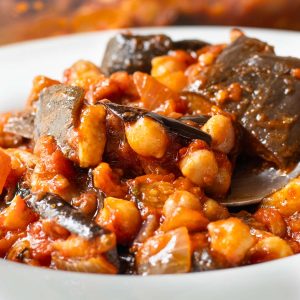
Vegetarian Lebanese Eggplant Moussaka with Chickpeas
Ingredients
- 1 cup cooked/canned chickpeas (⅓ cup dried chickpeas)
- 3-4 eggplants (aubergines)
- sunflower oil (or other oil for frying eggplants)
- 1 medium sized onion
- 6 garlic cloves
- 2 cups tinned tomatoes (whole or chopped)
- 2 tablespoon tomato paste
- 2 teaspoon dried mint
- salt
- pepper
Instructions
- Soak & Cook Dried Chickpeas. Ideally start this stage a day ahead. If using canned chickpeas, ignore this step and skip straight across to Step 2.Soak. Put the water into a bowl and add the bicarbonate of soda, stir to dissolve. Add the dried chickpeas. Make sure that the chickpeas are well covered with the water, as they will swell during the soaking. Soak the dried chickpeas for at least 12 hours. Boil. Boil the chickpeas (making sure always covered with water) until cooked. This takes about 1 hour to 1 hour 30 mins.
- Cut the eggplants (aubergines) into roughly 1.5cm (0.5 inches) cubes. Peel and finely chop the onions and garlic cloves.
- Put oil into a frying pan, preferably a sauté pan, so that it is about 1cm in depth. Heat the oil. I heat the oil until I can see it shimmering very slightly on the surface. Frying the eggplant cubes in batches, I make sure that the cubes are not tightly packed and keep to just one layer in the frying pan. I fry the cubes until they start to change colour and go brown on one or two sides.
- Using a slotted spoon, I remove the cooked aubergine (eggplant) from the frying pan and drain each batch of cooked eggplant using a colander or sieve to remove some of the excess oil.
- Separately, I put olive oil in a frying pan and add the chopped onions, together with a pinch of salt. Cook the onions over a medium heat so that they soften, to the point of starting to “melt” and lose their shape. Add the chopped garlic and continue cooking for a further couple of minutes, stirring to ensure that the all the garlic is gently fried.
- Add the tomatoes (if using whole tomatoes chop these first), mint (if using) and tomato paste to the onion mixture. Stir and continue to cook for about 20 minutes or so over a low heat. Add salt and black pepper to taste.
- Add the chopped eggplants and cooked chickpeas (or canned if using) to the tomato mixture. Stir so that all ingredients are mixed well. Taste and adjust the seasoning as needed. If the mixture starts to look too dry, add a little water to maintain the rich tomato sauce.
- Put the mixture into a baking dish. Bake the chickpea and aubergine stew for about 30 minutes.

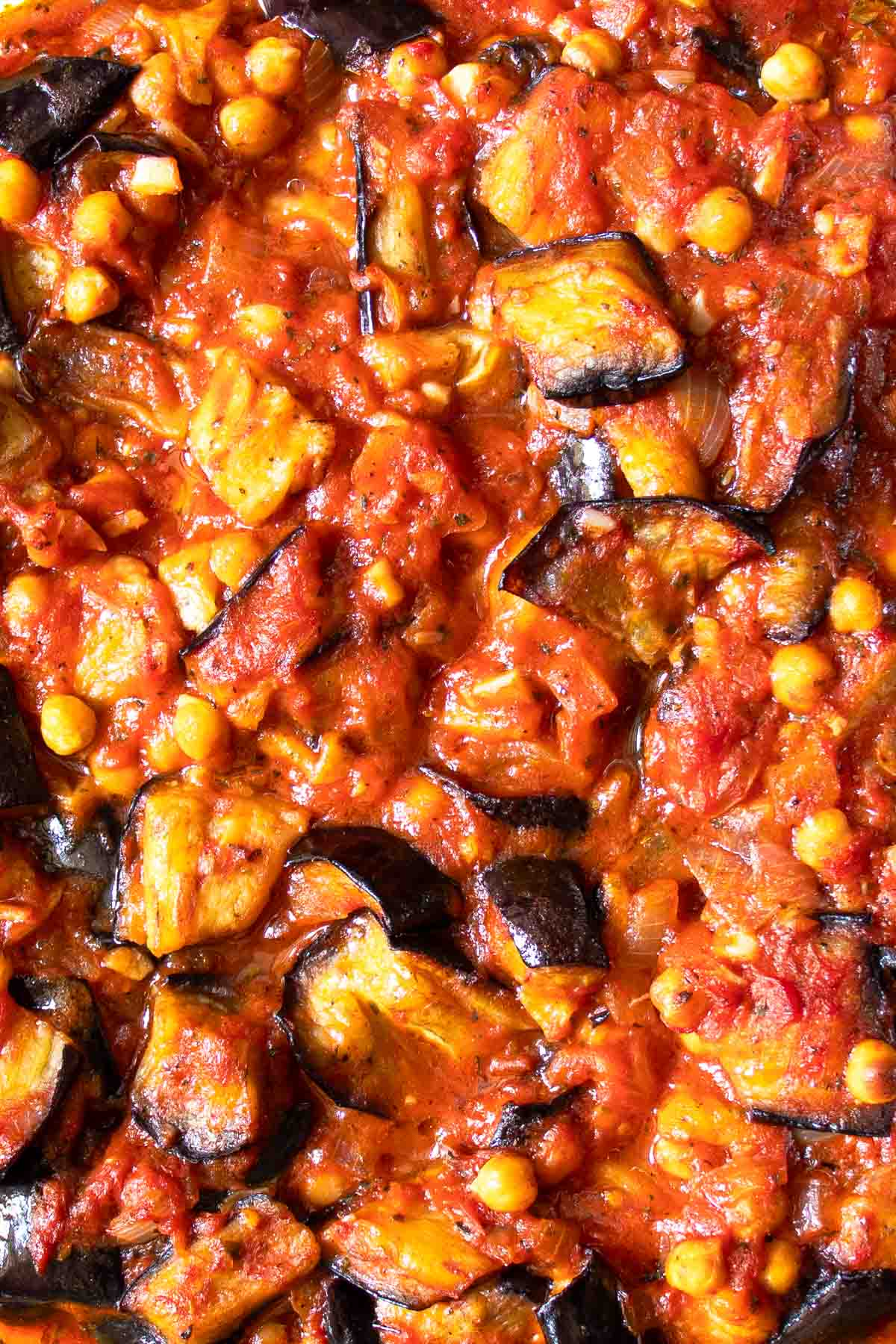
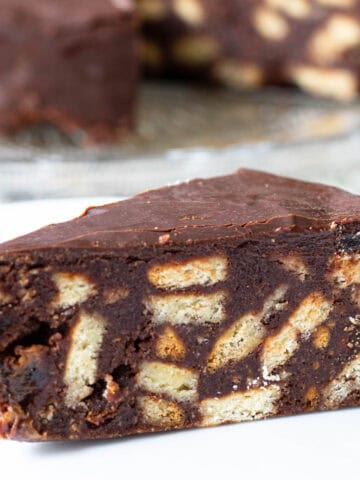


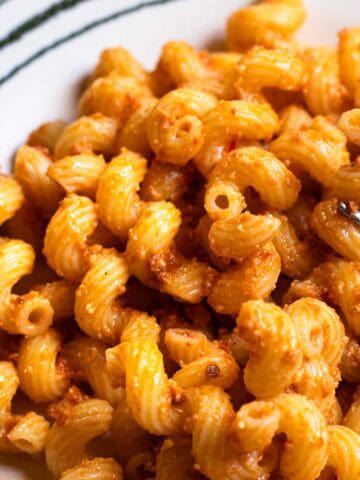
Leave a Reply